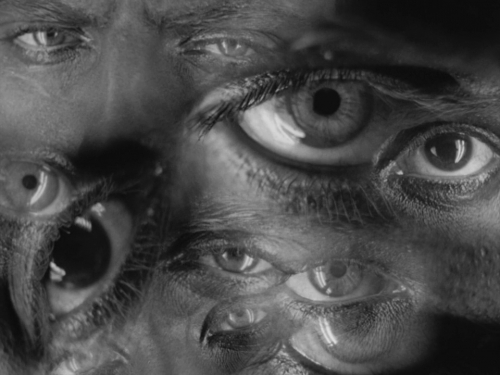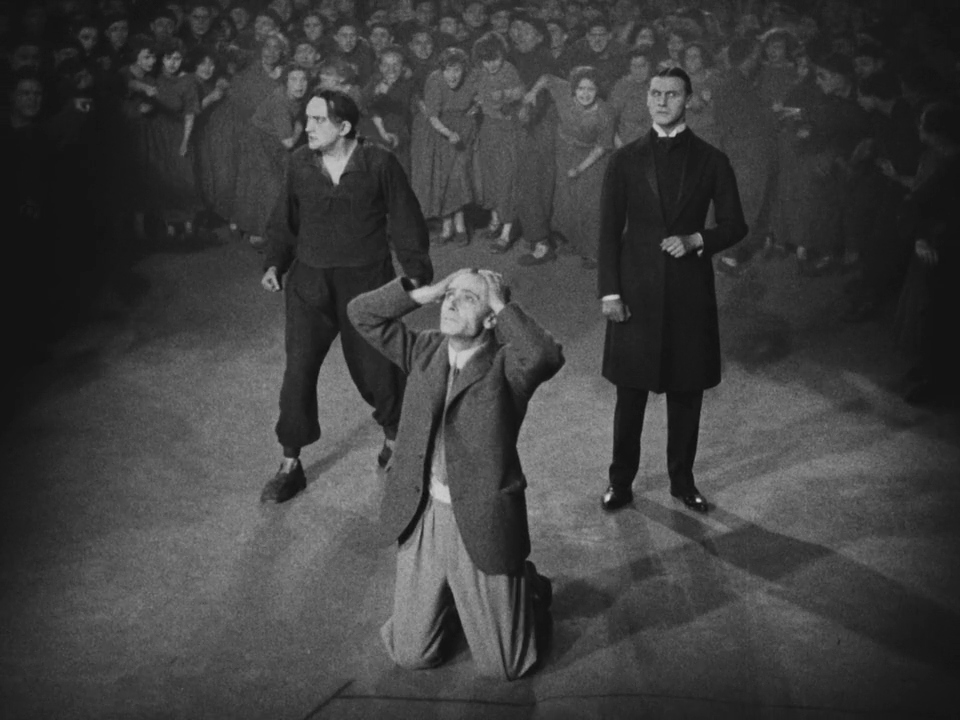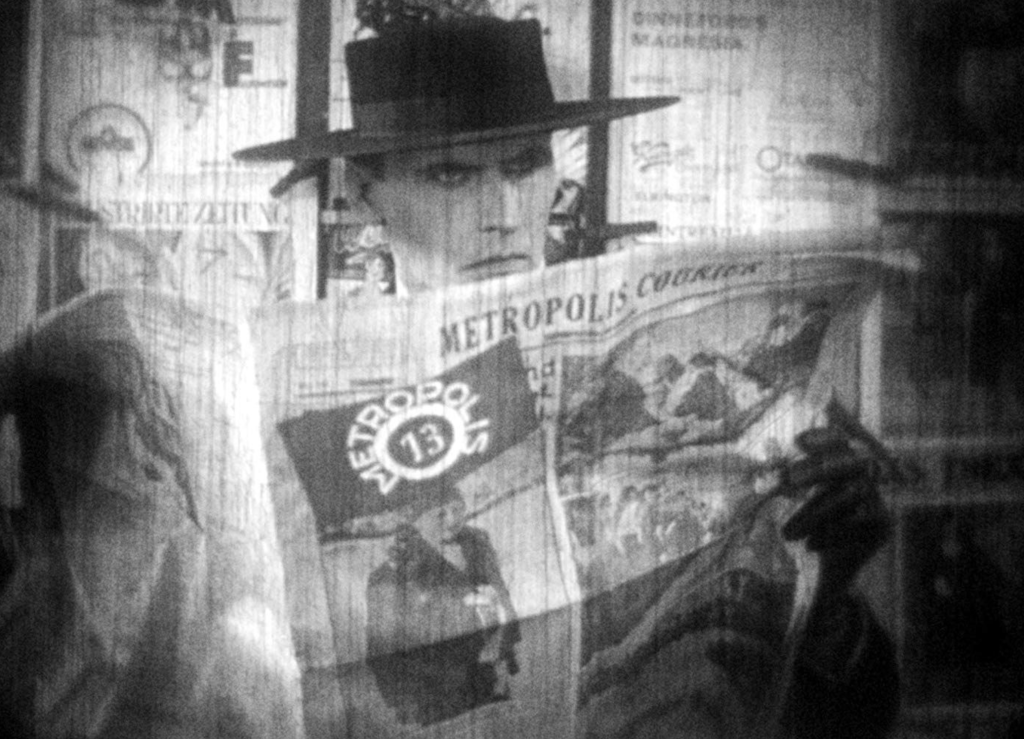Metropolis continues Die Niebelungen’s temporal mishmash, but what was merely confusing in Niebelungen becomes an essential part of Metropolis’s power. Most science fiction builds the future on the foundation of the present — Metropolis is, if not unique, then close to it in extending that foundation into the distant past. Rotwang lives in a house “forgotten for centuries” where he works with an unholy fusion of science and black magic: note the ever-present pentagrams and the alchemical device sitting in his wood stove. The climax takes place in a Gothic cathedral. Much of the second act takes place in the Ancient Roman catacombs. The Machinen-Mensch’s death deliberately evokes Medieval witch-burning as she cackles all the way to her grave.
It’s a uniquely European interpretation of the genre in that way, separating it from the wider body of work of science fiction that comes out of America, a country founded a bare two to three centuries ago on an alleged blank slate, and anyone who disagrees can get shipped off to the reservation. The historical imagery is still predominant in American sci-fi, but only as an aesthetic; after all, it’s easier to build a future from the leftovers of the past than to create one from scratch. In his subtle way, that’s what Lang does too, reinforcing the symbolism of the Metropolis as a decadent modern-day Babylon by adding Babylonian ziggurats to the skyline.
Lang and Von Harbou also take a deeply medieval outlook; possible maybe because the generic conventions weren’t set in stone (Flash Gordon occupies a similar space). After all, writers couldn’t even decide what to call it — Amazing Stories launched a few years earlier under the banner of “scientifiction.” But Metropolis’ few predecessors, most notably Wells and Verne, applied a ruthlessly scientific outlook to every aspect of their work, not just the gadgets and gizmos.
Metropolis leaves more room for the supernatural and irrational. James asked why people are so willing to trust its hero, Freder, given his tendency to feverish hallucinations. I’d answer that these aren’t just hallucinations. Freder is a literal visionary, providing some of the film’s most striking imagery, like the statue of Death — another Medieval relic — playing a bone pipe to lead the Seven Deadly Sins like the Pied Piper and slashing at the viewer with his scythe. And then, of course, there’s the Moloch Machine, another fusion of futuristic and ancient imagery as the engine turns into a gaping-mouthed idol and the workers it “devours” into human sacrifices. And as striking as that image is, the intertitle, normally a no-frills way of conveying information, is just as striking, as jagged abstract shapes form into the demon’s name.
The editing in the Yoshiwara sequence suggests that Freder can’t just see the essence of things, but their actuality from miles away. (The real question is if, as if the son of Joh Fredersen, his full name is Freder Fredersen, something the intertitles wisely don’t draw attention to.) It would take the mainstreaming of mysticism in the ‘60s and ‘70s for supernatural visions to reenter the genre in works like Dune and Star Wars. And even with two of the genre’s biggest franchises using the device, the visions in Metropolis still feel shockingly, bracingly incongruous with this mechanized future world.
Metropolis puts Lang and Von Harbou outside the rigidly logical fiction that had dominated science fiction up to that point and into the parallel, intuitive logic of fairy tales, myths, and dreams. It’s impossible to tell what any of these mammoth machines do, and that can’t be anything but deliberate. After all, we’re seeing them from the workers’ perspective, something like an unwilling version of the Light Brigade: they don’t know what they’re doing or why, but they have no choice except to keep fighting and dying for it. Playwright Channing Pollock justified butchering the film so badly that only half of it was available for decades by saying in Lang’s original, “symbolism ran such riot that people who saw it couldn’t tell what the picture was all about.”
Well, yes, Channing, that’s the whole point. (He also added, ominously, “I have given it my meaning.”) This is a work of symbolist art. It’s often been described as “style over substance” but the style is the substance — images of Jungian power that have haunted the world for nearly a century. Besides, it’s hard to imagine any audience would be such rubes they could miss the few symbols that map cleanly onto a single meaning. It’s already obvious that Freder’s manipulations of the arms on a giant light-up dial, which apparently keeps the machine from overheating in some mysterious way, represents the workers’ slavery to the clock. It’s obviouser when it’s juxtaposed with his father’s watch and the factory clock, and impossible to miss when Lang says “fuck subtlety” and superimposes the clock over the dial.
I throw the word “mythic” around a lot — most recently in connection with King Kong — but Metropolis is one of the few films that really deserve it, and certainly one of the few science fiction films. Even Star Wars, for all Lucas’s consultations with the great mythologist Joseph Campbell, doesn’t come close. Maybe it’s because, like the makers of Kong, he was more interested in providing a thrill a minute than exploring primal narratives and images. Metropolis is a thrill ride too, of course, but these are thrills that don’t just raise your heart rate but dig deeper into your soul.
Given the then-current party line that industrialization would create a worker’s paradise instead of Lang’s hellish undercity, it shouldn’t be surprising Metropolis never made it behind the Iron Curtain. But if the Soviets didn’t like Metropolis, Metropolis loves Soviet film. At first glance, The Cabinet of Dr. Caligari would seem to be the most experimental film in the German Expressionist canon when you compare the painstaking realism of the Metropolis to the near-abstraction of Caligari’s Holstenwall. But Lang makes room for groundbreaking experiments that seems to have more in common with the Soviet montage movement, experiments that are still shocking even now: the collage of wet, staring eyes watching the Robo-Maria dance or the even more complex superimposition of faces of all sizes as she addresses the workers.
One of Metropolis’ many restorations uncovered composer Gottfried Huppertz’s notes, revealing that before his film got butchered, Lang intended Metropolis to include several scenes cut together as rapid-fire as Dziga Vertov and Sergei Eisenstein (who visited the set) — and pretty much no one else for the next thirty years. He even incorporates techniques viewers rarely see outside avant-garde shorts, scratching slashes and stars right into the negative to convey Freder’s fever-inducing shock at seeing Maria and his father together.
Of course, the Soviet censors, for once, had some pretty good reasons to dislike the film. For the first half, it seems to be a proudly leftist film, humanizing the unseen, dehumanized workers. But recognizing a problem doesn’t mean you have a coherent solution. The real Maria advocates nonviolence, and not even any of the nonviolent actions that could change things; just the passive nonviolence of waiting for someone else to come along and fix things, no matter how many of them die in the meantime. Martin Luther King might have been thinking of her when he described, “the white moderate who…prefers a negative peace which is the absence of tension to a positive peace which is the presence of justice.” Robo-Maria’s call to violent revolution seems a lot more reasonable, but that’s not how it’s presented. No wonder the Soviets, and most left/liberal-leaning viewers, didn’t like the idea of preventing revolution as a happy ending.
As James has pointed out, the solutions Lang and Von Harbou offer to the labor crisis aren’t solutions at all. Freder’s ascension to the role of Mediator leaves the dystopian status quo intact. No matter how many horrors we see Joh Fredersen perpetrate, the film itself never progresses beyond Freder’s childlike faith in his father before he discovers Joh’s monstrous side. Fredersen uses up workers like pieces of meat. His only redeeming feature is his concern for his son. And yet he gets to continue as the Master of the Metropolis. Then again, if Freder is the messiah, does that make Fredersen God? That would suggest either a very dim view of God or a disturbing inclination to worship a creature of horror.
And all Freder does is mediate with the mediator. Grot the foreman had already proven himself faithful to Fredersen — he rats out the labor organizers by handing over their maps of the catacombs and only turns on the Master of the Metropolis after following his order to let the workers destroy the Heart Machine and, by extension, their own homes. So we have a message movie without a message. How can “The mediator between the head and hands must be the heart” apply to real life? These are the tensions you get when you have a director who fled the Nazis and a writer who joined them. Assuming Lang had some control over the intertitles, it’s hard not to imagine him sniping at his wife/collaborator when the Thin Man says the hope of a mediator is the only thing keeping the workers docile.
But the images of “Metropolis” are so powerful that its incoherent narrative is almost irrelevant. So the plot is simplistic — so are myths. So the characters are simple — so are mythological characters. And many of these images hint at the harsh truths the script avoids. As Rüdiger Suchsland repeatedly asks in the documentary From Caligari to Hitler, what do the movies know that we don’t? Lang obviously has his pulse on the times, the Weimar era of “dancing on the volcano” of hyperinflation and the rising threat of Nazism. Robo-Maria interrupts a party during the citywide blackout by cheering, “Let’s all watch the world go to the devil!” That’s practically the whole plot of Cabaret in one sentence.
But other images hint at events Lang couldn’t possibly have seen coming. He probably never intended the leadenly marching lines of workers in the famous “Shift Change” scene to represent anything more than the drudgery of factory work. But looking at it now, it’s hard not to see the millions being marched off to die in concentration camps. Add in the prison-like jumpsuits and yarmulke-like work caps, and it becomes downright eerie. So does the vision of Moloch, as those same lines of deadened workers go marching into the jaws of the monster to be if not gassed, then steamed to death. Alan Moore and Kevin O’Neill certainly saw it. In their League of Extraordinary Gentlemen spinoff Nemo: The Roses of Berlin, we see Charlie Chaplin’s Great Dictator has converted the Moloch Machine into a concentration camp.
It’s easy to laugh at how over-the-top Lang goes in his combination of German Expressionist technique and mythic narrative. But if you take the small steps necessary to get on his wavelength, it becomes clear these flaws are actually virtues. Even scenes like the bug-eyed Joh Fredersen, his head literally in his hands, staring at his son’s battle with Rotwang, have a power more realist filmmakers can’t touch.
The Thin Man was one of the great discoveries of the uncut print in Argentina (the story, fittingly enough, seems like it could have been dreamed up by the great Argentinian fabulist Jorge Luis Borges) and one of the great movie villains of all time (along with Rotwang, the Machinen-Mensch, and just about every other villain in Metropolis). Lang and actor Fritz Rasp push Expressionist filmmaking into the realm of Expressionist painting. They defy anatomy to create a character who’s almost nothing but straight lines and harsh angles, especially under the shadow of his block-shaped, wide-brimmed hat. He rarely commits violence directly, but there’s never any doubt he’ll make good on his threats. His presence itself has all the force of a threat. And there’s room for subtler acting too. When Heinrich George as Grot lets the rioters into the Heart Machine, he barely looks at the lever as he angrily kicks it open, conveying both his resentment at Fredersen’s orders and his hope to absolve himself by putting in as little effort as possible.
But the cast MVP is Brigitte Helm, who, to quote James again, plays polar opposites within the same film, both the Madonna and the whore. Her performance as Maria is especially astounding, tapping into the uncanny valley before real-life robotics was advanced enough for the phrase to be coined. Her eyelids are never quite open the same amount. As she stirs the workers to revolt, she bends in unnatural positions. (Something else O’Neill faithfully recreated in Nemo.) Yes, the dance scene doesn’t always work — it’s hard to imagine men being driven to a frenzy of lust that ends in murder and suicide by virtuoso moves like turning her head back and forth like she’s watching a tennis game, or doing the Egyptian in slow motion. But the scene starts out strong, with Helm briefly turning contortionist, swaying so smoothly you’d swear she’d lost her spine. These are images that have haunted moviegoers for the past hundred years, and probably will just as long as we’ve been haunted by images of Sun Wukong riding his cloud or the Theseus descending into the labyrinth to hunt the Minotaur.







